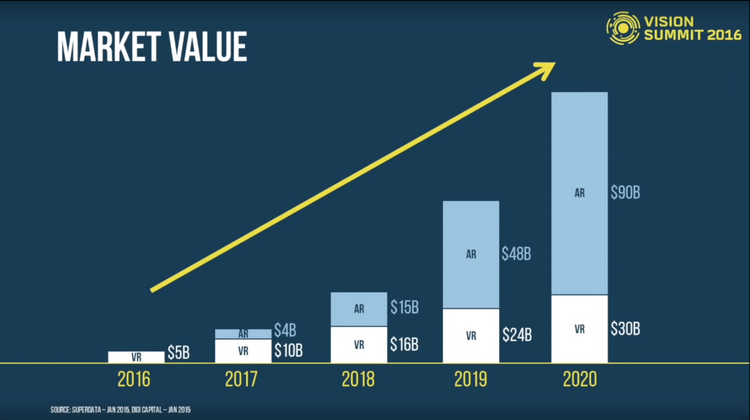Use cases for AR & VR: some thoughts on the experience
AR and VR are here to stay it seems, as big companies are investing a lot of money into a market that’s projected to be worth more than $30 billion by 2018 and $120 (!) billion by 2020. That’s a pretty big market to get a piece of, and it’s no wonder a lot of companies are scrambling to prepare for the big boom that’s supposed to be coming this year. As MagicLeap says: “it's time to bring magic back into the world.TM“ There will be some awesome magic wands around, and if you want to be part of the show, you either bring your own magic wand - which has to be pretty darn good - , or you bring the rabbit. A rabbit that’s meaningful, entertaining and educational or entertainingly useful.
Image from keynote speech of John Riccitiello, CEO, Unity Technologies at Vision Summit 2016
That’s where the challenge is technically. Come up with content that makes a difference in someone’s life (in a good way), and hide the tech behind it completely, so it’s as immersive as possible. It’s hard to hide a VR headset and make the person forget about it, but we love good challenge.
AR and VR is and will be useful in a lot of different situations. Besides obvious advantages in gaming and education, their impact on the corporate world will also be significant. We’ll talk about how these technologies will change the way corporations communicate, plan or manufacture goods in one of our next posts. Let’s focus on the entertainment and education side for now, and especially how VR and AR can be made a group experience instead of a lonely venture in the virtual world.
While wearing a VR HMD, you’re in a way disconnected from the real world. Even with AR smart eyewear, only you can see the virtual content, and even though you see the world around you, people next to you can only guess why you’re oohing and aahing. While it can be a very good thing, sometimes you just want to share the experience with others. With BroadcastAR for example, the experience is social. The audience see themselves on the screen, and they see others around them, they’re in the same space, share the same experience at the same time. A kid would run over to their mom happily that the astronaut just waved at them, and the mom would say she saw it. We’ve seen it many times, and can’t help but smile when you see the reactions on people’s faces.
The WOW delivered by INDE’s large-screen BroadcastAR Augmented Reality experiences
Sharing VR experiences can be done in a few ways. As we started developing our VERT system early on, we went with the “educational” or “guide” route: a person wearing the VR headset (Oculus Rift for example) enjoys the VR world as another person, let’s call him The Guide watches on a tablet. The Guide can tap on objects using the tablet, and the person in the VR world sees the same object highlighted. Or The Guide can trigger animations, start a storm, build a mountain or simply change the time of day. The Guide can also freely move around in the exact same virtual space. This can be extremely useful to guide or teach the person in the VR world about the environment.
As for people in the virtual world, they can interact with objects around using a number of different ways. We went with LeapMotion because seeing your hands in the virtual world really helps with the motion sickness. And of course we plan on supporting the devices already in development.
Sharing VR experiences doesn’t have to be a one-on-one experience. Multiple people can be connected to the same experience, using various devices. Participants can be in the same room or all over the world.
AR is a different breed in a sense that you actually see the real world around you. You’re not as disconnected from the real world, but if you’re wearing Hololens for example, the person next to you has no idea why you’re tapping the air. As Microsoft demonstrated in the video, there’s an easy way to get around that problem: hand the person a tablet and you’re good to go. Similar to our VERT VR platform, our Mobile AR application will have the capability to allow people to see the same content on multiple different devices.
We quickly realised that for people to enjoy it, the technology would have to be in the background, and the experience would have to be seamless. People would need to be immersed in the content and, if it ever came, the “how did they do that?” would have to come after the experience is over.
BroadcastAR powers most of our licensed experiences, quietly humming in the back, only occasionally making sounds as a trusted old companion. Its history isn’t too long, but it’s been constantly evolving in the past years, patiently dealing with our frequent patches and feature developments, maybe even smiling inside at one or two of our attempts to add some crazy features (we thought were technically great but…) no one really needed.

